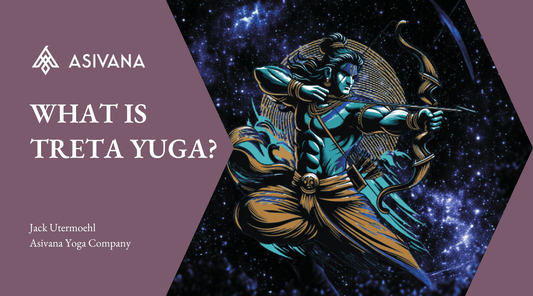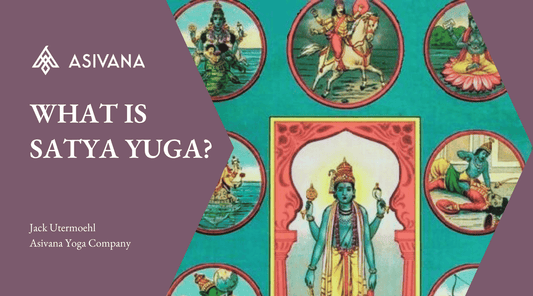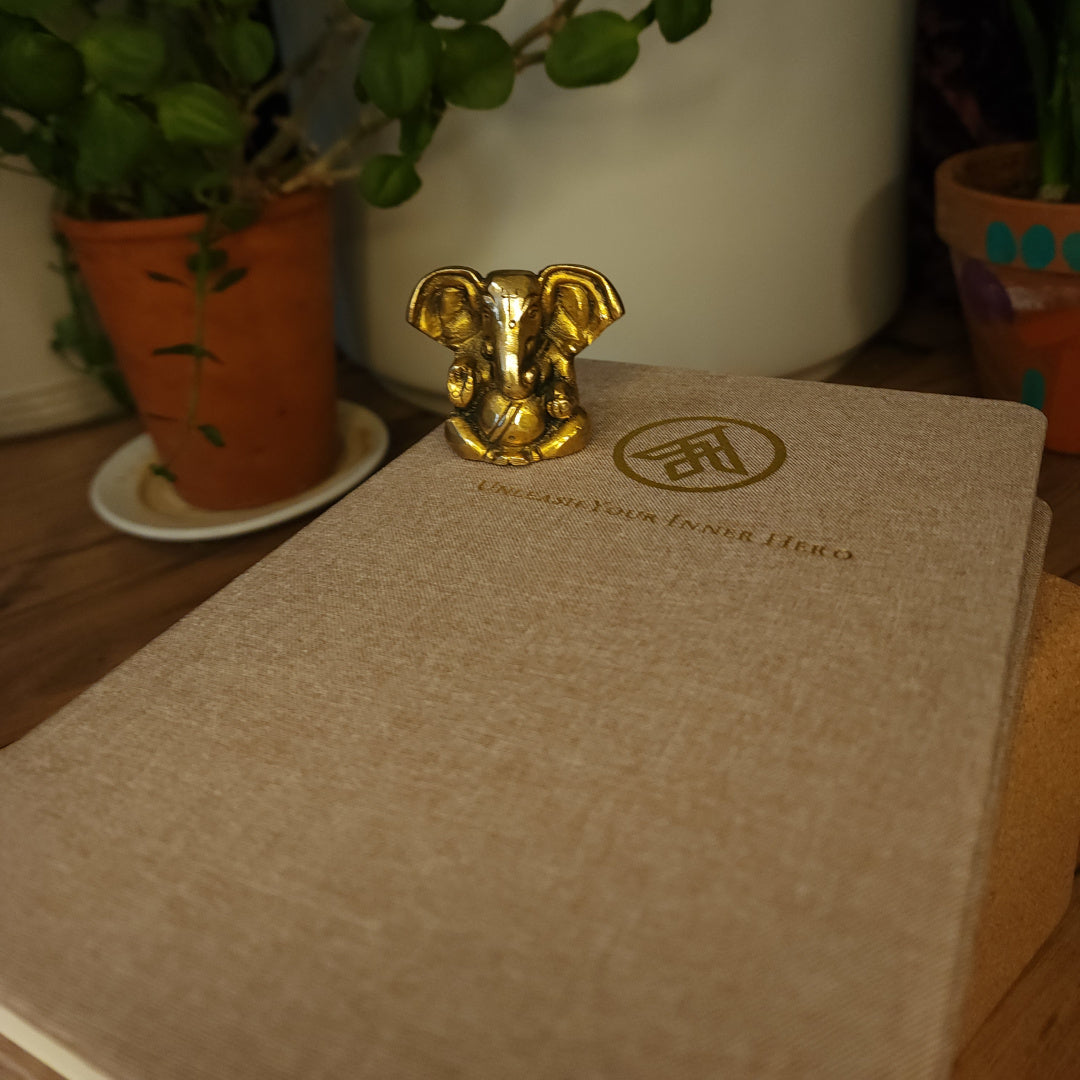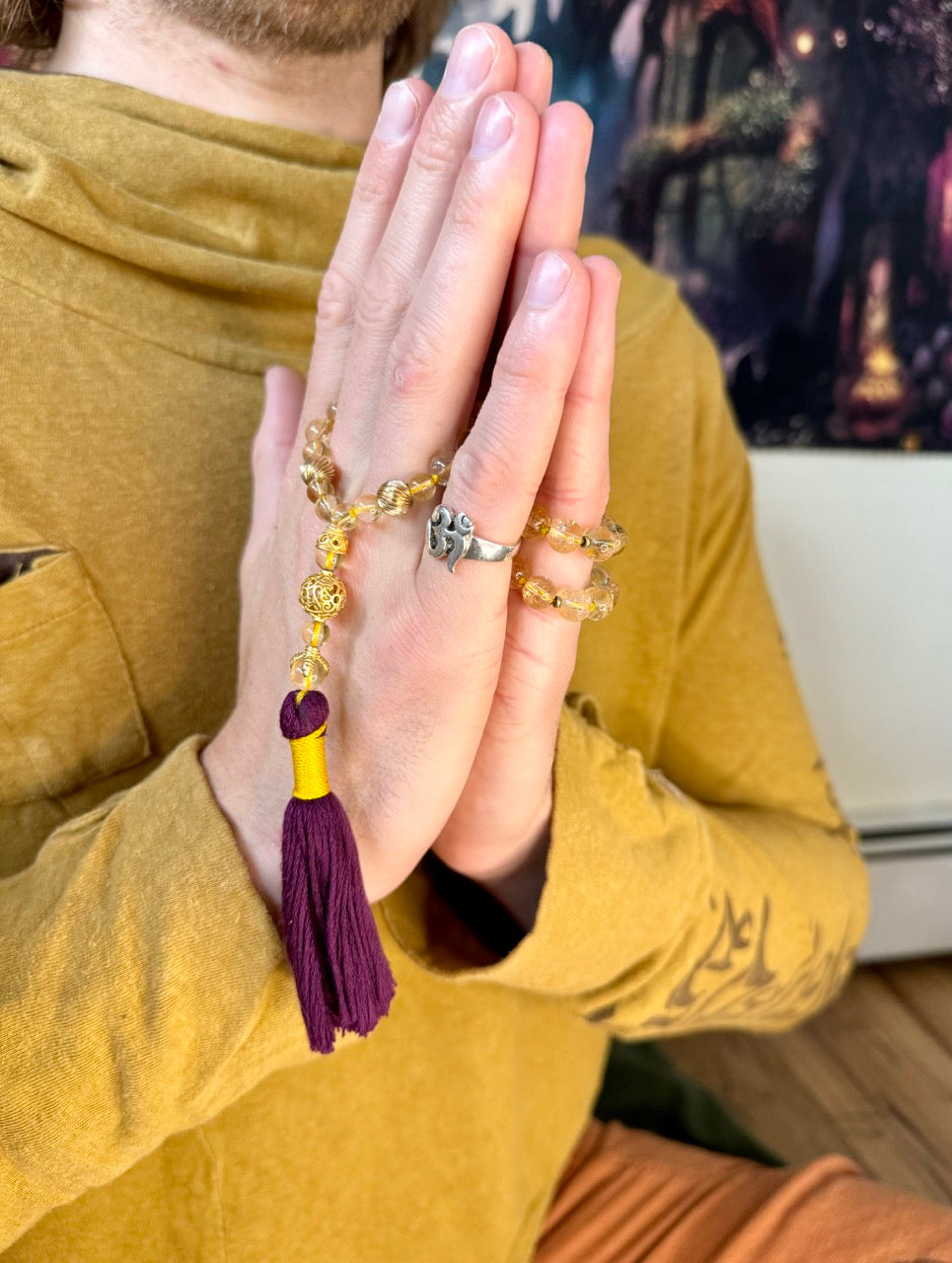
The History of Yoga
Jack UtermoehlTo enrich your experience, we invite you to listen to the audio companion below while reading about the ancient origins of yoga. Let the sound carry you into the depth of yoga’s earliest wisdom. Voice is AI generated and may mispronounce some Sanskrit words.
Ancient Origins of Yoga
Yoga’s roots trace back deep into antiquity, originating in the Indian subcontinent over 5,000 years ago. The earliest known references to yoga appear in ancient Sanskrit texts like the Rig Veda, where the term yoga (meaning “yoke” or “union”) is used in the context of control or harnessing of the mind. Early Vedic scriptures from around 1500–1000 BCE describe ascetic mystics (munis and keśins) who practiced breath control and meditation on the fringes of society. These wandering sages were precursors to later yogis, seeking spiritual insight outside the rituals of orthodox Brahmanism.
By the mid-1st millennium BCE, key ideas of yoga were being developed in the Upanishads (philosophical scriptures) and among the śramaṇa traditions (renunciate movements) of India. Texts from around 500–300 BCE (such as the Katha Upanishad) describe yoga as the inner practice of restraining the senses and concentrating the mind, a path to realizing the ātman (soul) and its union with brahman (the ultimate reality).
During this same era, Buddhist and Jain thinkers were also formulating meditative disciplines virtually identical to yoga – for example, the Buddha (5th century BCE) learned meditation from yogic ascetics and incorporated mindfulness and concentration practices into Buddhism. In essence, by 500–200 BCE yoga had evolved into a broad spiritual technology of mental discipline shared across Hindu, Buddhist, and Jain traditions.
It is worth noting that some scholars have speculated on even earlier yogic practices in the Indus Valley Civilization (c. 2500–2000 BCE). A famous seal found at Mohenjo-daro – the “Pashupati” seal – depicts a horned figure sitting cross-legged, which 20th-century archaeologists interpreted as a prototype of Shiva or a yogi in meditation. However, modern scholarship considers such interpretations highly speculative, since we cannot definitively decipher the Indus script or the figure’s meaning. In short, while the Indus artifacts are intriguing, the first concrete evidence of yogic ideas appears in the Vedic texts and ascetic traditions of ancient India.

Classical Era: Patanjali’s Yoga Sutras
By around the 2nd century BCE (or early centuries CE), yoga philosophy reached a classical formulation with the sage Patañjali. Patañjali’s treatise, the Yoga Sutras, distilled the diverse practices of yoga into a coherent system known as Rāja Yoga (the “royal path”).
This text – often dated to roughly the first few centuries of the Common Era – defines yoga famously as “Yogaś citta-vṛtti nirodhaḥ,” meaning yoga is the calming of the fluctuations of the mind. Patañjali outlined an eight-fold path or “Eight Limbs” of Yoga (Ashtanga Yoga) as the core of classical practice:
- Yama – ethical restraints (non-violence, truthfulness, etc.)
- Niyama – personal observances (purity, contentment, etc.)
- Āsana – physical postures
- Prāṇāyāma – breath control
- Pratyāhāra – withdrawal of the senses
- Dhāraṇā – concentration
- Dhyāna – meditation
- Samādhi – absorption or enlightenment
Importantly, in this classical definition, asana (posture) was just one part of yoga – a means to steady the body for meditation – rather than the goal in itself. The Yoga Sutras synthesized prior yogic concepts from Hindu Sāṃkhya philosophy and Buddhism, emphasizing mastery over the mind, detachment from material cravings, and attainment of kaivalya (liberation).
Patañjali’s work became the foundational scripture of yoga’s philosophical school (one of the six classical darshanas of Hindu thought) and it heavily influenced all subsequent yoga traditions. For centuries after Patañjali, yoga was understood primarily as a meditative and ethical discipline – a practice of mental concentration, breathing, and sense-withdrawal aimed at spiritual liberation.

Post-Classical Developments: Hatha Yoga and Tantra
In the medieval period (roughly 5th–15th centuries CE), yoga continued to evolve with significant new practices, especially under the influence of Tantra. Whereas classical Yoga (Patañjali’s Raja Yoga) had relatively little emphasis on complex postures or the physical body, the later Haṭha Yoga traditions placed the body at the center of the practice.
Beginning around the 9th–11th centuries CE, texts on Hatha Yoga (“Forceful Yoga”) started to emerge, introducing novel techniques to “force” the rising of spiritual energy within the body. Tantric-Yogic texts taught that the subtle life energy (prāṇa) could be channeled through chakras (energy centers) and nāḍīs (energy channels) by means of physical practices.
Yogic literature from this post-classical era (e.g. Goraksha Samhita, Hatha Yoga Pradipika) detailed dozens of asana postures, cleansing rituals (kriyās), mudrās (energy seals or gestures), and advanced prāṇāyāma techniques that were largely absent from the older sutras. The goal was to purify and strengthen the body so it could withstand the intense spiritual energy (kundalini) awakened through yoga.
For instance, the Hatha Yoga Pradipika compiled by Swami Swatmarama in the 15th century CE catalogued 15 core asanas and many breathing practices, setting the stage for the rich physical repertoire of modern yoga. During this period, yogis became known for amazing physical feats and austerities – from holding difficult poses for hours to controlling heart rate and body heat through breath – all intended to conquer the limitations of the body and mind in the quest for enlightenment.
By the 17th–18th centuries, aspects of yoga (especially Hatha practices) had spread beyond ascetics into broader Indian culture, but under later Mughal and British rule, yoga’s reputation suffered. Some European observers saw yogis as mere street fakirs (fakers) or contortionists, and certain yogic practices were discouraged or even banned by colonial authorities as superstition.
Nonetheless, the core lineage of yoga philosophy and practice survived in India’s spiritual monasteries and lineages – awaiting a modern revival.
Yoga’s Journey West: 19th-Century Revival
In the mid-19th century, Western intellectuals began taking interest in India’s ancient knowledge, including yoga. Translations of Sanskrit texts (like the Bhagavad Gita and Upanishads) and lectures by Indian scholars introduced Europe and America to yoga’s philosophical ideas. However, it was not until 1893 that yoga truly grabbed the West’s attention, thanks to a charismatic Hindu monk named Swami Vivekananda.
In September 1893, Vivekananda delivered a famous speech at the World’s Parliament of Religions in Chicago, where he spoke about Hinduism and yogic philosophy to a mesmerized audience. This event is often cited as a turning point – the moment yoga (as a concept) was first presented on the world stage. Vivekananda emphasized Vedanta and Raja Yoga (meditation and spiritual unity), teaching Westerners about the universality of the divine and the power of the mind.
He largely downplayed the physical postures, at times dismissing Hatha Yoga as “mere gymnastics” when speaking to American audiences. Instead, he taught yoga as a science of the mind and soul, publishing books like Raja Yoga (1896) that interpreted Patañjali’s sutras for a modern readership.
Vivekananda’s tour planted the seeds of interest in Eastern spirituality, opening the door for other Indian teachers. By the early 20th century, a trickle of yogis, gurus, and scholars followed to Europe and America.
For example, Swami Abhedananda and others from Vivekananda’s circle established Vedanta centers in the West around the turn of the century. These early presentations of yoga were almost entirely about meditation, philosophy, and ethics – there was little to no asana practice taught to the public at this time. Nonetheless, the idea of yoga as a path to inner peace and enlightenment was now introduced to Western thought.

The Modern Era: Yoga’s 20th-Century Transformation
In the early 20th century, yoga underwent a profound modern transformation, both in India and in the West. A new “Yoga Renaissance” was brewing in India, where a few pioneering teachers began to integrate traditional yoga with Western physical fitness techniques. During the 1920s and 1930s, figures like Swami Kuvalayananda and Tirumalai Krishnamacharya in India started to revive and reshape Hatha Yoga for a new era.
As historian Mark Singleton describes, this period saw Indian hatha yoga (physical yoga) traditions merged with Western forms of exercise and gymnastics to create the familiar posture-based practice we know today.
Swami Kuvalayananda, for example, conducted scientific research on yoga’s health benefits and framed yogic exercises in medical terms, lending them credibility. Krishnamacharya, supported by the Mysore palace, developed dynamic sequences of asanas (including the now-popular Sun Salutations), drawing partly on indigenous wrestling and gymnastic moves to build strength and flexibility.
This “modernized” yoga – a blend of ancient spirituality with modern physical culture – would soon spread worldwide.
Meanwhile, some of Vivekananda’s successors continued bringing spiritual yoga to the West. In 1920, Paramahansa Yogananda arrived in America to attend a conference of religious liberals in Boston. He ended up settling in the U.S. and teaching Kriya Yoga, a form of meditative yoga, to thousands of students. Yogananda’s Autobiography of a Yogi, published in 1946, became a spiritual classic and inspired countless Westerners with its stories of Indian yogis and mystics.
Due to restrictive immigration laws in the 1920s, fewer Indian teachers could come to the West for a time. However, Western enthusiasts began traveling to India to seek yoga instruction instead. One notable example was Theos Bernard, an American who journeyed to India and studied Hatha Yoga in the 1930s; he published Hatha Yoga: The Report of a Personal Experience (1947), one of the earliest American accounts of physical yoga practice.
By the mid-20th century, the physical practice of yoga had finally made its way to mainstream Western audiences. A landmark figure in this shift was Indra Devi (born Eugenie Peterson), a Russian noblewoman turned yogini. In 1938–47 she studied under Krishnamacharya in India, becoming the first Western woman trained in yoga. In 1947 Indra Devi opened a yoga studio in Hollywood, where she taught asanas to film stars and housewives, sparking American popular interest in yoga’s health benefits. Her bestselling books (like Forever Young, Forever Healthy, 1953) had everyday Americans practicing headstands in their living rooms.
Around the same time, two of Krishnamacharya’s most illustrious Indian students – B.K.S. Iyengar and K. Pattabhi Jois – began gaining renown.
Iyengar introduced his precise, alignment-focused style of yoga (later called Iyengar Yoga) and in 1966 published Light on Yoga, a comprehensive guide to yoga postures that became an international bestseller sometimes nicknamed “the Bible of Modern Yoga”.
Pattabhi Jois developed Ashtanga Vinyasa Yoga, a vigorous flowing style, and by the 1970s he was teaching it to eager Western students in Mysore and California. Another influential teacher, Swami Sivananda of Rishikesh, had been training many disciples in India – and these disciples (like Vishnudevananda, Satchidananda, and others) carried Sivananda’s integrated yoga of postures, breath, and devotion to North America and Europe in the 1950s and 60s.
From the 1960s onward, yoga’s popularity exploded in the West through a convergence of counterculture interest, media exposure, and a growing wellness movement. As Indian gurus arrived in greater numbers – Maharishi Mahesh Yogi with Transcendental Meditation, Yogi Bhajan with Kundalini Yoga, etc. – young people in the West, particularly in the hippie and New Age movements, embraced yoga as part of a broader search for consciousness expansion and alternative lifestyle.
At the same time, secular proponents were presenting yoga in a non-spiritual, health-oriented way. Pioneers like Richard Hittleman and Lilias Folan brought yoga onto television in the 1960s and 70s, teaching simple yoga routines to millions of viewers at home.
Their programs and books cleverly packaged yoga as a gentle form of exercise and relaxation accessible to anyone. By the 1980s and 1990s, yoga had firmly entered the Western mainstream. Fitness companies produced yoga VHS tapes for home use, and gyms added yoga classes to their aerobics schedules.
A flourishing industry of yoga magazines, yoga studios, and teacher training programs emerged to meet the demand. What had once been an esoteric Eastern practice of renunciates was now a trendy practice for stress relief, flexibility, and wellness across North America and Europe.
Notably, as yoga globalized, many Western practitioners initially approached it as purely a physical exercise, sometimes separated from its spiritual roots. Yet, over time, interest in the deeper philosophy has grown. For example, Yoga Journal (founded 1975) and other publications began educating practitioners on the full spectrum of yoga, including meditation, ethics, and philosophy.
This blending of East and West came full circle: Indian yoga masters appreciated yoga’s surge in popularity abroad, and Western yogis started delving into classical texts and spiritual lineages. By the end of the 20th century, yoga had transformed into a diverse global phenomenon – encompassing sweaty power yoga classes in Los Angeles, meditation retreats in the mountains of India, and everything in between.

Yoga in the 21st Century: A Global Phenomenon
Entering the 21st century, yoga’s momentum has only increased, blossoming into a worldwide cultural and fitness movement. The numbers speak volumes about yoga’s global reach today: over 300 million people practice yoga worldwide on a regular basis. In the United States alone, roughly 1 in 10 people (34 million+) are yoga practitioners, a figure that quadrupled between 2001 and 2016.
Once exotic, yoga is now a multi-billion dollar industry – the global yoga market is estimated to be worth upwards of $80+ billion including classes, clothing, mats, and teacher trainings. There are tens of thousands of yoga studios across Western Europe, North America, Australia, and beyond, and in countries like India and China interest in modern yoga as exercise is also surging.
In 2014, the United Nations even recognized yoga’s universal appeal by declaring an official International Day of Yoga. Every year on June 21 (the summer solstice), massive public yoga events are held in cities from New York to New Delhi, with millions of people in over 80 countries participating. This unprecedented global celebration – spearheaded by India’s Prime Minister Narendra Modi – highlights yoga as a unifying practice of wellbeing beyond any single religion or culture.
Leaders and celebrities around the world have taken up yoga: from athletes and movie stars to political figures who tout yoga and meditation for managing the stresses of modern life. Yoga’s vocabulary (terms like karma, chakra, and namaste) has entered common usage in many languages. Furthermore, scientific research in medicine and psychology has validated many benefits of yoga – from improving flexibility and heart health to reducing anxiety – encouraging schools, hospitals, and workplaces to incorporate yoga-based programs for wellness.
Despite its immense modernization, the essence of yoga remains what it has always been: a practice of uniting body, mind, and spirit. Contemporary yoga comes in myriad styles and flavors – you can find everything from power vinyasa flow classes, to gentle restorative yoga, to hybrid innovations like aerial yoga or goat yoga. There are vigorous hot yoga studios for fitness enthusiasts, as well as meditation-focused studios emphasizing mindfulness.
This diversification means yoga is accessible to nearly everyone, regardless of age or background. Yet, underlying all these variations is the same fundamental aim that Patañjali or the ancient rishis would recognize: to attain balance, self-awareness, and inner freedom. As one scholar aptly noted, “Yoga has become for many a practice to achieve liberation – liberation from the fear, stress, and alienation of modern life”.
The history of yoga is a living, breathing story that continues to unfold. From its birth in the mystic past of India to its current status as a beloved global practice, yoga has shown a remarkable ability to adapt and endure. It has survived through millennia, crossing oceans and cultural barriers, precisely because its core speaks to something universal in human experience – the longing for wholeness and peace.
Today’s yoga practitioners, even those initially drawn in for a good workout, often find themselves curious about the deeper philosophies and traditions behind the poses. In this way, modern yoga is coming full circle to reconnect with its roots. As we move further into the 21st century, yoga’s ancient wisdom blended with new innovations will no doubt continue to evolve, helping people everywhere to “yoke” together their physical health, mental well-being, and spiritual insight – just as it has done for thousands of years.
Sources:
Explore The Ancient Roots of Yoga — Google Arts & Culture
8 Limbs of Yoga : A Detailed Guide for Beginners 2025
History of Yoga: Origins to Modern Day | OriGym
Hatha Yoga Pradipika Index | Sacred Texts Archive
Why We Practice: A Short History of Yoga in the West
Yoga Landed in the U.S. Way Earlier Than You'd Think—And Fitness Was Not the Point | HISTORY
How Yoga found a home in America from these Yoga pioneers - Guyana Times










